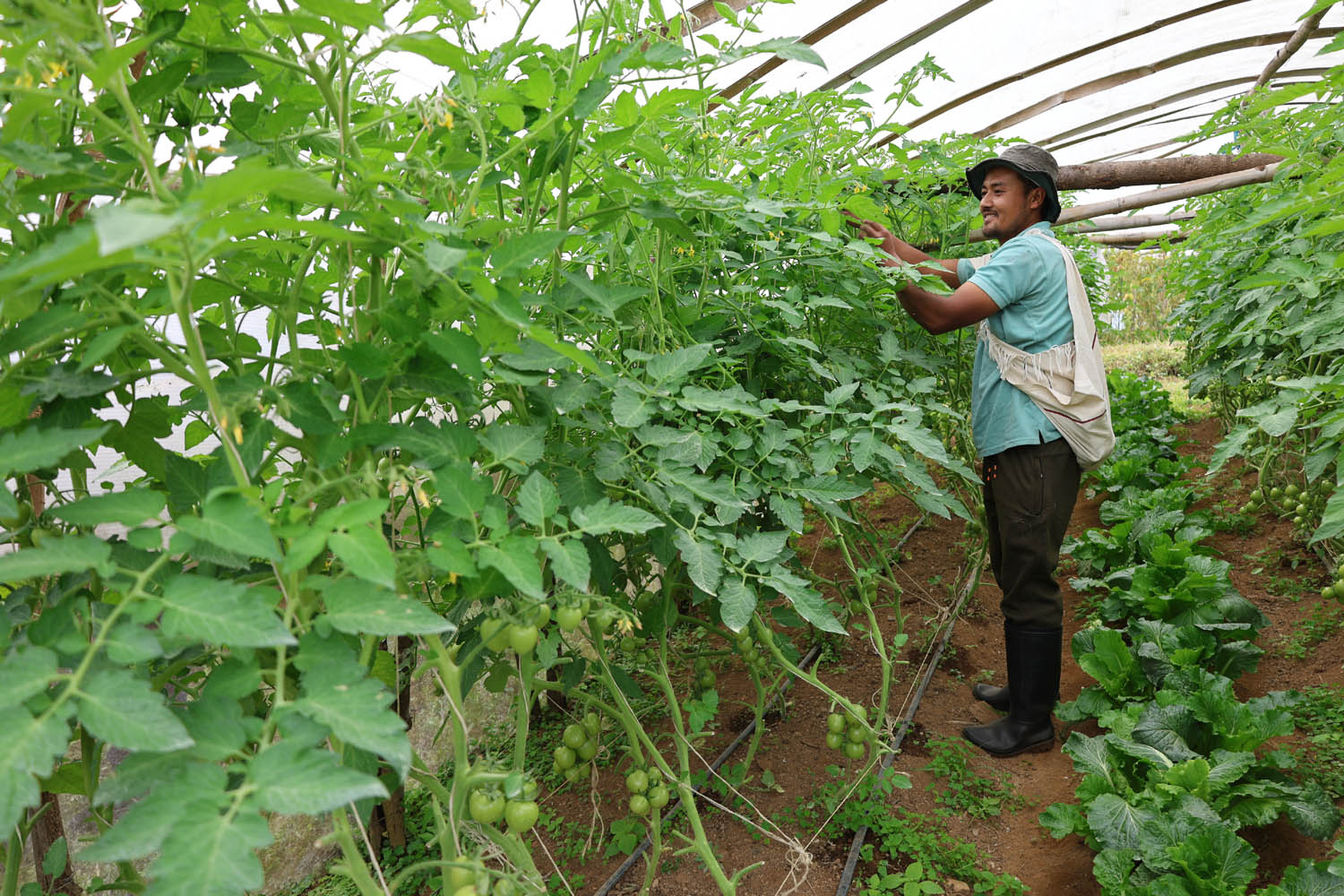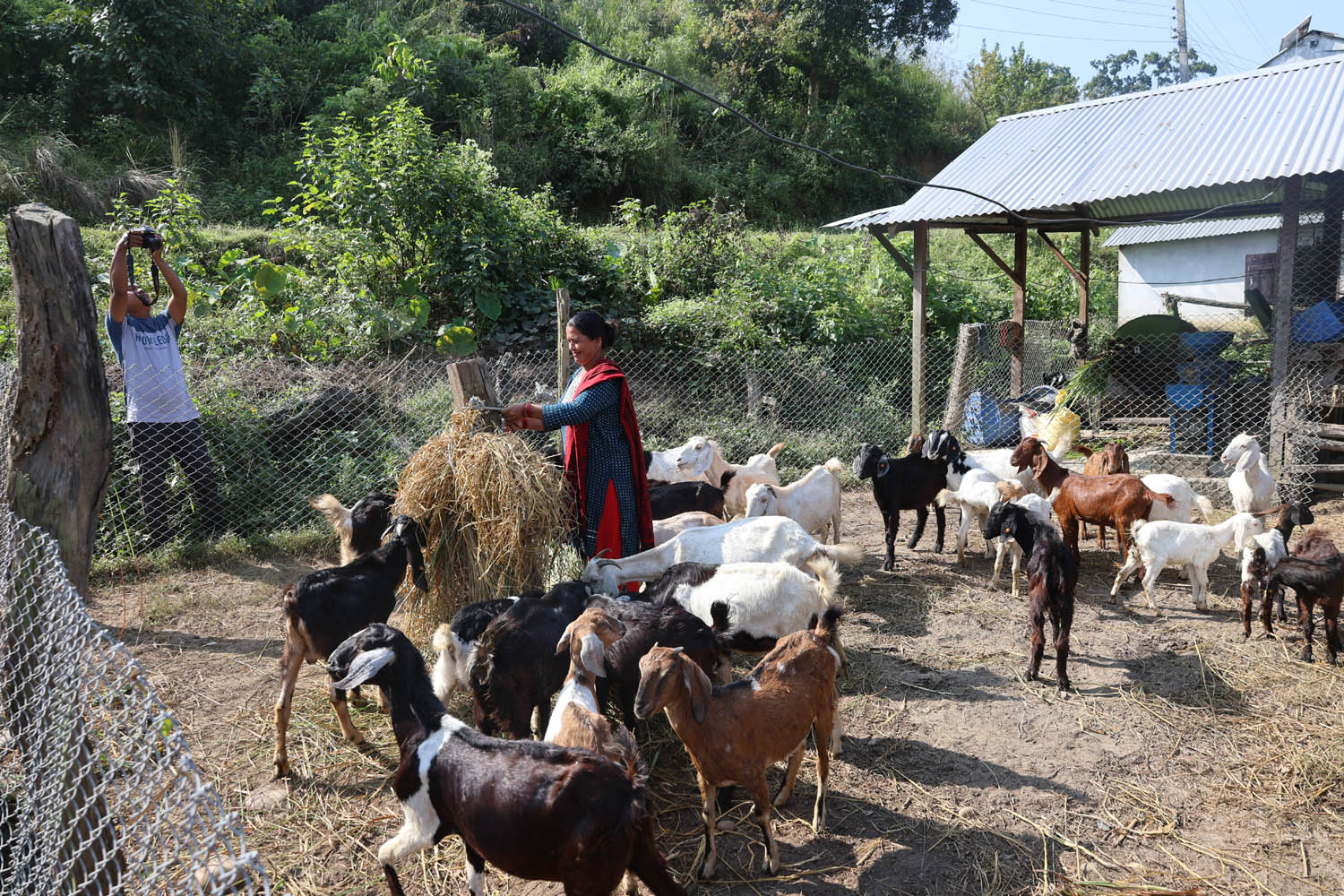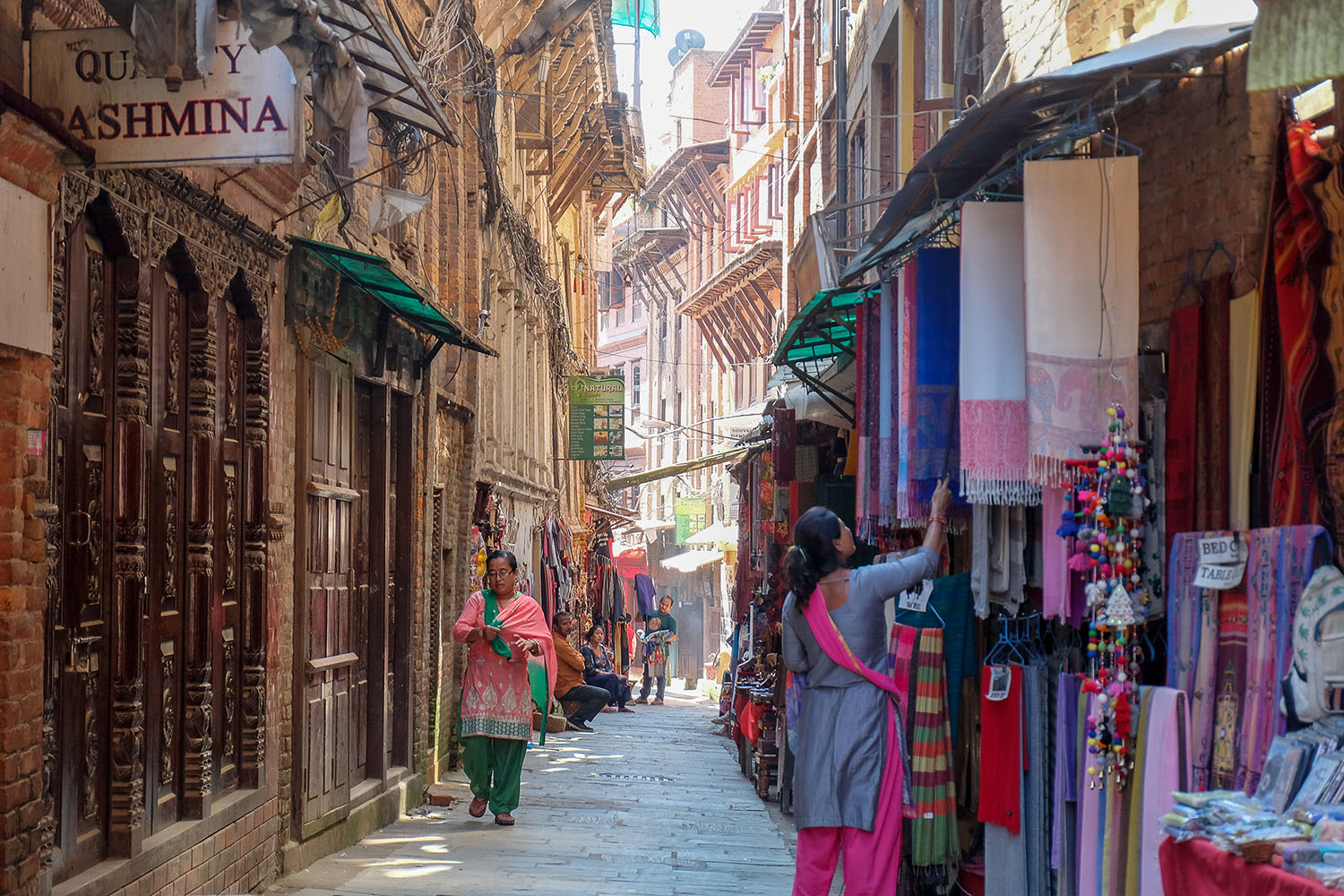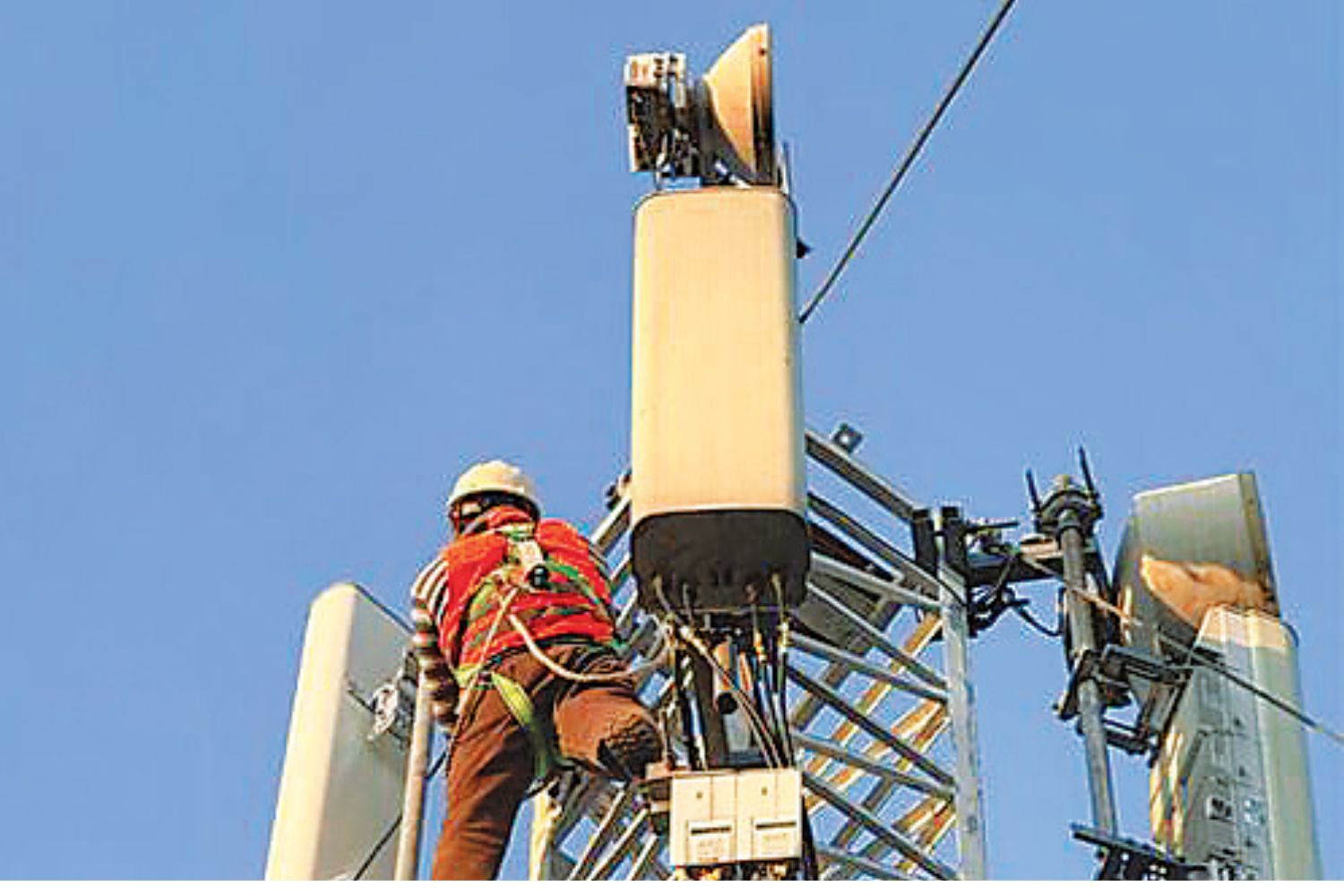Money
Success stories: Microcredit loans are transforming rural entrepreneurship
With more returnee migrants taking up agribusiness, the average size of farm loans has risen from Rs1.5 million to Rs5 million.
Sangam Prasain
An old and traditional mud house stands in Lahachowk at 1,730 metres above sea level, in Kaski, on the northern rim of Pokhara. The house is surrounded by a dozen plastic tunnels spread over 100 ropani (5.09 hectares), filled with tomatoes and leafy vegetables.
Farm owner Bhoj Bahadur Tamang, 33, is seen wearing a Tamang dress and gumboots. He has a shawl on his back, where he carries a sickle and Namlo, ply-split porters’ headbands for carrying heavy loads.
He is one of the budding farm entrepreneurs. But behind his success, there is a long story of struggle.
Tamang, from a socially and economically marginalised ethnic group, worked in a hotel in Pokhara after finishing school. “From childhood, I dreamed of doing it on my own. Then I decided to open a restaurant,” he said. “I took a loan of Rs300,000 from my friends and family and opened a restaurant in Pokhara.”
“But I was not comfortable with the business. I decided to go abroad.”
He then flew to Kuwait in 2014. “I worked there for 10 months. It was not easy, as I had to toil day and night. I thought if I spent the same time in Nepal, I could earn more,” he said. He returned to Nepal and started tunnel farming in Lwang-Ghalel village.
Plastic tunnels are small greenhouse-like structures that cover the plants. They are similar to greenhouses, where plants are cultivated under semi-controlled conditions to protect them from excess sunlight. These tunnels are erected with bamboo and covered with clear plastic.
Tamang started with ten tunnels. “But I didn’t get support from my relatives or my neighbours,” said Tamang. “My neighbours started to scold me. They told me if I worked here and earned money, no one would go abroad.”

The 2015 earthquake caused some potential migrants to cancel their migration plans. In the aftermath, the number of labour migrants from Nepal who went to foreign employment destinations decreased sharply.
The reason was attributed to the resettlement and financial needs of their homes. Many prospective workers decided to stay and take care of their families.
However, the migrant workers’ exodus began soon, with no jobs at home, mainly due to political instability and thriving corruption. Last fiscal year, nearly a million Nepalis, including students, left the country to try their luck abroad.
Only a few people like Tamang decided to stay and do something. “One day, my neighbours left their buffaloes loose in my tunnel and destroyed everything. I filed a complaint and was compensated, but that particular event made me more determined,” said Tamang.
He changed his farm location and built 23 tunnels.
Tamang’s fortunes changed when he was shortlisted for the Israeli government’s “Learn and Earn” lottery scheme.
“The 11 months of training changed my life. I learned about plants, agriculture systems, technology and how to become an entrepreneur.”
In 2018, he went to Israel and returned after 11 months.
He has leased 104 ropani [5.29 hectares] of land and is doing integrated farming—producing grass for goat rearing in 60 percent of the farm while the remaining 40 percent is set aside for vegetables.
His farm is entirely organic.
Tamang has an insect trap net and a proper irrigation system, but most importantly, he produces off-season vegetables, which doubles the value of his products.
He currently owns 58 goats after selling 50 this year.
Tamang sells 3,000 kg of vegetables daily; 1,000 kg of this is leafy.
Tamang has taken a Rs3.2 million loan from Sana Kisan Bikas Laghubitta Bittiyasanstha, a microcredit organisation formerly known as Sana Kisan Bikas Bank, and invested Rs12 million in the past four years.
His annual sales hover around Rs5 million, of which his net profit is Rs1.8 million.
In Majhthana, a remote hill station of Kaski, we met Chandra Kanta Ghimire, another returnee migrant who owns 10 Murrah buffalos. These water buffaloes originate in Haryana and Punjab of India and are mainly kept for milk production.
The 51-year-old farmer has recently bought a washing machine. “Life is too easy with machines,” he said. “If there is technology, we can double and triple income on the farm.”

Life was not easy for Ghimire decades ago. “I went to Saudi Arabia paying Rs350,000,” he said.
“I worked in Saudi for six years and used to earn 500 riyals, which was around Rs 15,000 a month. “That was too little as 250 riyals used to be spent on food and house rent.”
After his return in 2006, he brought two buffaloes and started selling milk. “The income was also not enough to eke out a living for a family of five,” he said, adding that he decided to take out a loan seven years ago to expand his farming.
He took Rs200,000 loan, also from Sana Kisan Bikas Laghubitta Bittiyasanstha Ltd. His appetite for loans grew.
Eleven months ago, he took another Rs2.3 million loan from Sana Kisan and added more buffalos. “I spent Rs600,000 to erect a shed and have decided to add two buffaloes this year.”
Ghimire said that a Murrah buffalo costs Rs170,000. “I milk 50 litres a day, making a monthly income of Rs147,000 by selling it at Rs115 per kg.”
Ghimire dreams of buying a car from the income in the next four to five years.
In a far-flung Kharkatta village of Madi, Chitwan, the Post also caught up with Ganga Bahadur Adhikari, who has turned goat farming into a thriving business. He has six children—five daughters and a son.
He recently sold goats worth Rs800,000 to Madi Municipality. “Normally, I make Rs1 million from goal sales annually, including the manure,” said Adhikari. He previously reared buffalos using traditional methods, but decided to switch to goat rearing a few years ago.
“The key to my success is the training I got from the veterinary doctors,” he said.
Initially, he took out a loan of Rs500,000 to rear goats and decided to scale up his business by taking another loan of Rs2.5 million from Sana Kisan Bikas Laghubitta Bittiyasanstha Ltd.
He has Khari and Boer crossbred goats. “The crossbreed has a bigger body weight and faster growth. This breed grows 35 kg in a year,” he said.

Adhikari, who owns three bigha [2.03 hectares] of land, produces Napier grasses on ten kattha [0.34 hectares].
He has also insured his goats. The premium he pays per goat is Rs20, which is 20 percent, and the government insures the remaining 80 percent.
“If you do it commercially, there is a good return.” His goat-rearing model has a spillover effect, as many of his neighbours have started following him.
“Meat demand is rising due to the burgeoning income of people, and I see good prospects.”
According to the Ministry of Agriculture and Livestock Development, the country used to import up to 600,000 goats annually, and now this figure has been slashed by 97 percent, thanks to commercial goat rearing.
Nav Raj Simkhada, deputy chief executive officer of Sana Kisan Bikas Laghubitta Bittiyasanstha, highlighted the organisation’s standout achievement—a 100 percent loan recovery rate.
“We don’t just give loans, we also help farmers prepare business plans, which is one of the biggest difficulties farmers face.”
“Besides, we interact with youth by organising exposure visits to successful projects and motivate them to embrace commercial farming and entrepreneurship,” he said, adding that Sana Kisan provides loans to cooperatives, which then lend to farmers.
“We also bring PUM Netherlands senior experts, a volunteer organisation committed to the sustainable development of Small and Medium-sized Enterprises in developing countries, to offer practical knowledge and expertise within the most important sectors of the economy.”
He said that with growing commercial farming and youth engagement, the capacity of farmers to use loans has increased.
“We used to extend Rs700,000 until the fiscal year 2015-16, a maximum individual limit, which grew to Rs1.5 million. Farmers’ capacity has grown, and most of the farmers associated with us are seeking Rs5 million to scale up their operations.”
Sana Kisan Bikas Laghubitta Bittiyasanstha has extended loans totalling Rs35 billion through cooperatives. Currently, it has Rs130 billion in savings and farmers’ shares.
In 2019, the Asian Development Bank approved a $50 million loan to promote rural entrepreneurship in Nepal. The government distributes the ADB loan to small farmers through the Sana Kisan Bikas Laghubitta Bittiyasanstha Ltd. According to the ADB, the project supports about 500 small farmers (at least 30 percent being women) with loans of up to Rs5 million.
The project aims to improve the livelihoods and increase the incomes of small farmers.
“We have invested Rs4.5 billion,” said Simkhada.
He said Sana Kisan can now lend up to Rs5 million to individuals and Rs20 million to institutional borrowers. “Initially, our target was to lend Rs5 million to 500 farmers. The number has increased to 2,000.”
Agritech entrepreneurs have emerged as key players in addressing the agricultural sector’s challenges.
Neelina Nakarmi, an economics analyst at the ADB in Nepal, said farmers are revolutionising farming practices, increasing productivity, and promoting sustainable agriculture through innovative technology.
The examples provided are just a glimpse of the inspiring stories of successful entrepreneurs who positively impact the country’s food system.
“After commercial farming, our next project will focus on the value chain—all the steps involved in bringing food from the farm to the plate, from growing food to storing and processing it,” said Nakarmi. “This initiative will encourage more and more farmers to be entrepreneurs.”




 16.09°C Kathmandu
16.09°C Kathmandu





